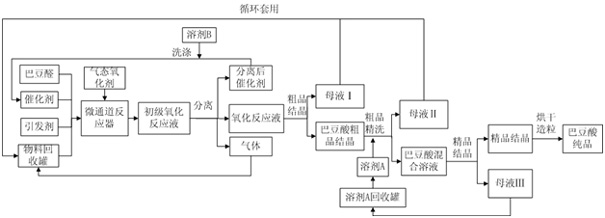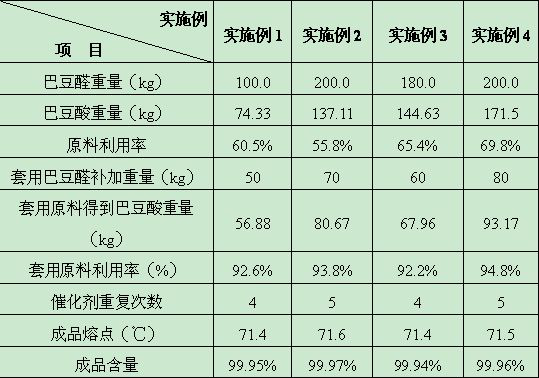Method for industrially producing crotonic acid by adopting microchannel reactor
A micro-channel reactor, a technology for industrial production, applied in chemical instruments and methods, separation/purification of carboxylic acid compounds, preparation of carboxylate salts, etc. Process development and other issues, to achieve the effect of reducing production steps, avoiding a large number of emissions, and shortening the reaction time
- Summary
- Abstract
- Description
- Claims
- Application Information
AI Technical Summary
Problems solved by technology
Method used
Image
Examples
Embodiment 1
[0049] A kind of method adopting microchannel reactor industrial production crotonic acid, carries out according to the following steps:
[0050] S1. Material oxidation process: Cobalt acetate, activated alumina, and iron phosphomolybdate are used in a weight ratio of 1:1:1 to form a composite catalyst, and the initiators are selected from acetonitrile, dimethylformamide, and dimethylacetamide in a weight ratio of 1 :1:2 composite initiator. The gaseous oxidant is passed into the silicon carbide ceramic plate microchannel reactor, the gaseous oxidant is oxygen+air, and the consumption of the gaseous oxidant (according to O 2 The molar weight of the form) is 25±2% of the mass of crotonaldehyde. When the pressure in the silicon carbide ceramic plate microchannel reactor reaches 1.6MPa, the crotonaldehyde, catalyst, and initiator (weight ratio 1:0.015:0.15) are mixed and pre- After heating to 30~35°C, inject it into the microchannel reactor through a metering pump, the materia...
Embodiment 2
[0057] A kind of method adopting microchannel reactor industrial production crotonic acid, carries out according to the following steps:
[0058] S1. Material oxidation process: Cobalt acetate, activated alumina, and iron phosphomolybdate are used in a weight ratio of 1:1:1 to form a composite catalyst, and the initiators are selected from acetonitrile, dimethylformamide, and dimethylacetamide in a weight ratio of 1 :1:2 composite initiator. The gaseous oxidant (air + oxygen) is passed into the silicon carbide ceramic plate microchannel reactor, and the amount of oxygen oxidant (according to O 2 The molar weight of the form) is 30±2% of the mass of crotonaldehyde. When the pressure in the silicon carbide ceramic plate microchannel reactor reaches 0.8MPa, mix and preheat the crotonaldehyde, catalyst, and initiator (weight ratio 1:0.01:0.30) After reaching 30~35°C, it is injected into the microchannel reactor through a metering pump, the material flow rate is 900±10ml / min, the ...
Embodiment 3
[0065] A kind of method adopting microchannel reactor industrial production crotonic acid, carries out according to the following steps:
[0066] S1. Material oxidation process: Cobalt acetate, activated alumina, and iron phosphomolybdate are used in a weight ratio of 1:1:1 to form a composite catalyst, and the initiators are selected from acetonitrile, dimethylformamide, and dimethylacetamide in a weight ratio of 1 :1:2 composite initiator. The gaseous oxidant (air + oxygen) is passed into the silicon carbide ceramic plate microchannel reactor, and the amount of the gaseous oxidant (according to O 2 The molar weight of the form) is 35±2% of the mass of crotonaldehyde. When the internal pressure of the silicon carbide ceramic plate microchannel reactor reaches 1.8MPa, the crotonaldehyde, catalyst, and initiator (weight ratio 1:0.015:0.20) are mixed and pre- After heating, it is injected into the microchannel reactor through a metering pump, the material flow rate is 1000±10ml...
PUM
| Property | Measurement | Unit |
|---|---|---|
| particle diameter | aaaaa | aaaaa |
| melting point | aaaaa | aaaaa |
Abstract
Description
Claims
Application Information
 Login to View More
Login to View More - R&D
- Intellectual Property
- Life Sciences
- Materials
- Tech Scout
- Unparalleled Data Quality
- Higher Quality Content
- 60% Fewer Hallucinations
Browse by: Latest US Patents, China's latest patents, Technical Efficacy Thesaurus, Application Domain, Technology Topic, Popular Technical Reports.
© 2025 PatSnap. All rights reserved.Legal|Privacy policy|Modern Slavery Act Transparency Statement|Sitemap|About US| Contact US: help@patsnap.com


